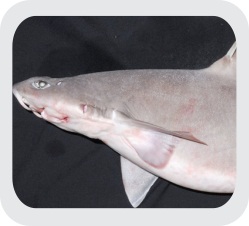Rare shark species
discovered in Western Australia
 The
mandarin dogfish, Cirrhigaleus barbifer, is the only species in this
genus found in Western Australia, and represents a significant range
extension and first record in Australia. Most Cirrhigaleus sharks
are clearly separable from other squalid sharks by the presence of
conspicuous barbels on the anterior nasal flaps. Cirrhigaleus
barbifer may be distinguished from its close relative C. australis
by the structure of the CO1 gene and key measurements. In addition,
this is only the second record of a gravid female of C. barbifer,
with pups in an advanced stage of development. New data on the
reproductive biology and range of C. barbifer are included.
The
mandarin dogfish, Cirrhigaleus barbifer, is the only species in this
genus found in Western Australia, and represents a significant range
extension and first record in Australia. Most Cirrhigaleus sharks
are clearly separable from other squalid sharks by the presence of
conspicuous barbels on the anterior nasal flaps. Cirrhigaleus
barbifer may be distinguished from its close relative C. australis
by the structure of the CO1 gene and key measurements. In addition,
this is only the second record of a gravid female of C. barbifer,
with pups in an advanced stage of development. New data on the
reproductive biology and range of C. barbifer are included.
Associated media coverage: NBC News, Science Alert, Live Science...
Assessing the potential
for post-copulatory sexual selection in elasmobranchs
 This
review highlights the potential role that post-copulatory sexual
selection plays in elasmobranch reproductive systems and the utility
of this group to further understanding of evolutionary responses to
the post-copulatory processes of sperm competition and cryptic
female choice. The growing genetic evidence for female multiple
mating (polyandry) in elasmobranchs is summarized. While polyandry
appears to be common in this group, rates of multiple paternity are
highly variable between species suggesting that there is large
variance in the strength of post-copulatory sexual selection among
elasmobranchs. Possible adaptations of traits important for post-copulatory
sexual selection are then considered. Particular emphasis is devoted
to explore the potential for sperm competition and cryptic female
choice to influence the evolution of testes size, sperm morphology,
genital morphology and sperm storage organs. Finally, it is argued
that future work should take advantage of the wealth of information
on these reproductive traits already available in elasmobranchs to
gain a better understanding of how post-copulatory sexual selection
operates in this group.
This
review highlights the potential role that post-copulatory sexual
selection plays in elasmobranch reproductive systems and the utility
of this group to further understanding of evolutionary responses to
the post-copulatory processes of sperm competition and cryptic
female choice. The growing genetic evidence for female multiple
mating (polyandry) in elasmobranchs is summarized. While polyandry
appears to be common in this group, rates of multiple paternity are
highly variable between species suggesting that there is large
variance in the strength of post-copulatory sexual selection among
elasmobranchs. Possible adaptations of traits important for post-copulatory
sexual selection are then considered. Particular emphasis is devoted
to explore the potential for sperm competition and cryptic female
choice to influence the evolution of testes size, sperm morphology,
genital morphology and sperm storage organs. Finally, it is argued
that future work should take advantage of the wealth of information
on these reproductive traits already available in elasmobranchs to
gain a better understanding of how post-copulatory sexual selection
operates in this group.
Associated media coverage: UWA News...
Research Paper: Fitzpatrick JL, Kempster RM, Daly-Engel TS, Collin SP, Evans JP (2012) Assessing the potential for post-copulatory sexual selection in elasmobranchs. Journal of Fish Biology 80: 1141-1158.
